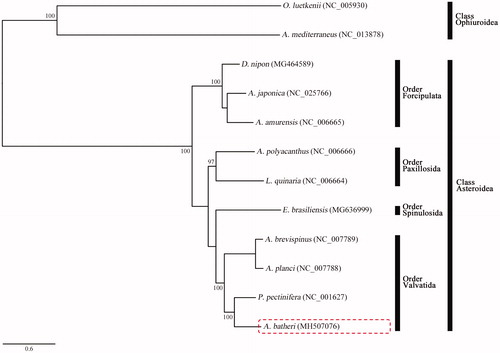Abstract
In this study, we determined the complete mitochondrial genome sequences of Aquilonastra batheri. This is the first study on mitochondrial genome sequencing of the genus Aquilonastra belonging to the family Asterinidae, order Valvatida, and class Asteroidea. The complete mitogenome of A. batheri was 16,463 bp and consisted of 13 protein-coding genes (PCGs), 22 tRNAs, and two rRNAs. The orders of PCGs and rRNA genes were identical to those of nine recorded mitogenomes of asteroids. The phylogenetic tree determined by the maximum likelihood method revealed that A. batheri was clearly grouped with Patiria pectinifera, which belongs to the family Asterinidae.
A sea star genus Aquilonastra was removed from the genus Asterina in 2004, based on a molecular and morphological revision (O’Loughlin and Waters Citation2004). A total of 31 species of the genus Asterina have been reported to date worldwide, and these species have extensive distribution, from Korea to Australia and Maldives, Arabian Sea, Red Sea, Indonesia, and Papua New Guinea (Clark Citation1921; O’Loughlin and Rowe Citation2006; Shin Citation2010; O’Loughlin and Bribiesca-Contreras Citation2015, Citation2017). Aquilonastra batheri is a common species found in the shallow water of Jeju-do, whose morphological characteristics are as follows: small sized (>30 mm), oral side flattened, with various marked irregular patterns on the aboral side (Shin Citation2010).
Specimens were collected by SCUBA diving at a depth of 21 m from the Munseom Island, Jeju-do in Korea (33°13′38″N, 126°34′08″E) on 29 March 2018. Specimens were deposited in the Marine Echinoderm Resources Bank of Korea (Seoul, Korea). The method of mitochondrial DNA extraction and amplification, next-generation sequencing (NGS), and genomic library conformed with those in the study by Lee and Shin (Citation2018). Phylogenetic analyses of the dataset were performed using the maximum likelihood (ML) method with PhyML 3.1 (Guindon et al. Citation2010). The best-fit substitution was estimated using jModelTest 2.1.1 (Guindon and Gascuel Citation2003; Darriba et al. Citation2012) for the nucleotide dataset of 13 protein-coding genes (PCGs). For ML analyses, PhyML were used with the GTR + G model of substitution for the nucleotide dataset. Bootstrap resampling was performed using the rapid option with 1,000 iterations.
The complete mitogenome of A. batheri (GenBank accession No. MH507076) was 16,463 bp and contained 13 PCGs, 22 tRNA genes, and two rRNA genes. The order and direction of the genes were identical to those of the other nine complete mitogenomes of asteroid species. Eleven PCGs contained an ATG initiation codon (methionine), with the exception of NADH4L (ATC, isoleucine) and NADH3 (ATT, isoleucine). The TAA codon was the termination codon of nine PCGs, with the exceptions of COX2, NADH2, NADH5 (TAG), and CytB (Phenylalanine (TTC)+T).
To examine the phylogenetic relationships, the ML method was used based on the nucleotide sequences of 13 PCGs obtained from ten asteroids, including A. batheri (), with two ophiuroids, Astrospartus mediterraneus (NC_013878) and Ophiura luetkenii (NC_005930), which were used as outgroups. In the phylogenetic tree, the ten asteroid mitogenomes were clearly divided with two ophiuroids (). Aquilonastra batheri formed a distinct monophyly with Patiria pectinifera (NC_001627), which belonged to the family Asterinidae. Furthermore, they distinctly formed a monophyletic clade with Acanthaster brevispinus (NC_007789) and A. planci (NC_007788), which belongs to the identical order Valvatida ().
Disclosure statement
No potential conflict of interest was reported by the authors.
Additional information
Funding
References
- Clark HL. 1921. The echinoderm fauna of Torres Strait: its composition and its origin. Washington (DC): Publication of the Carnegie Institution of Washington.
- Darriba D, Taboada GL, Doallo R, Posada D. 2012. jModelTest 2: more models, new heuristics and parallel computing. Nat Methods. 9:772
- Guindon S, Dufayard JF, Lefort V, Anisimova M, Hordijk W, Gascuel O. 2010. New algorithms and methods to estimate maximum-likelihood phylogenies: assessing the performance of PhyML 3.0. System Biol. 59:307–321.
- Guindon S, Gascuel O. 2003. A simple, fast, and accurate algorithm to estimate large phylogenies by maximum likelihood. System Biol. 52:696–704.
- Lee T, Shin S. 2018. Complete mitochondrial genome analysis of Distolasterias nipon (Echinodermata, Asteroidea, Forcipulatida. Mitochondrial DNA. doi:10.1080/23802359.2018.1501313.
- O’Loughlin PM, Bribiesca-Contreras G. 2015. New asterinid seastars from northwest Australia, with a revised key to Aquilonastra species (Echinodermata: Asteroidea). Memoirs of Museum Victoria. 73:27–40.
- O’Loughlin PM, Bribiesca-Contreras G. 2017. New asterinid seastars from the western Pacific Ocean (Echinodermata: Asteroidea). Memoirs of Museum Victoria. 76:121–132.
- O’Loughlin PM, Waters JM. 2004. A molecular and morphological revision of genera of Asterinidae (Echinodermata: Asteroidea). Memoirs of Museum Victoria. 61:1–40.
- O’Loughlin PM, Rowe FWE. 2006. A systematic revision of the asterinid genus Aquilonastra O’Loughlin, 2004 (Echinodermata: Asteroidea). Memoirs of Museum Victoria. 63:257–287.
- Shin S. 2010. Sea Star: Echinodermata: Asterozoa: Asteroidea. Invertebrate fauna of Korea, Vol. 32, No. 1. Incheon: National Institute of Biological Resources. p. 1–150.

